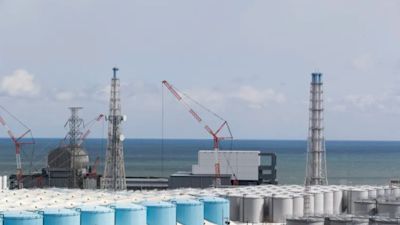Japan to release one million tonnes of radioactive water from Fukushima plant into ocean

Japan has announced it will release more than one million tonnes of radioactive water from the wrecked Fukushima nuclear plant into the Pacific Ocean.
The long speculated decision, which has been delayed for years owing to safety concerns and protests, came at a meeting of Cabinet ministers who endorsed the ocean release as the best option.
However, the decision is fiercely criticised by local fishermen and residents - who have opposed the moved for years.
The accumulating water has been stored in tanks at the Fukushima Daiichi plant since 2011, when a massive earthquake and tsunami damaged its reactors and their cooling water became contaminated and began leaking.
The plant’s operator, Tokyo Electric Power Co (TEPCO), said its storage capacity will be full late next year.
Prime Minister Yoshihide Suga said the ocean release was the "most realistic" option and that disposing the water is "unavoidable" for the decommissioning of the Fukushima plant, which is expected to take decades.
TEPCO and government officials have said tritium - which is not harmful in small amounts - cannot be removed from the water, but all other selected radionuclides can be reduced to levels allowed for release.
The government has said the work to release the diluted water will begin in about two years, however the entire process is expected to take decades.
"On the premise of strict compliance with regulatory standards that have been established, we select oceanic release," it said in a statement.
Some scientists have said the long-term impact on marine life from low-dose exposure to such large volumes of water is unknown.
Under the basic plan adopted by the ministers, TEPCO will start releasing the water in about two years after building a facility under the regulatory authority’s safety requirements.
It said the disposal of the water cannot be postponed further and is necessary to improve the environment surrounding the plant so residents can live there safely.
In the decade since the tsunami disaster, water meant to cool the nuclear material has constantly escaped from the damaged primary containment vessels into the basements of the reactor buildings.
To make up for the loss, more water has been pumped into the reactors to continue to cool the melted fuel.
The government has said it will do the utmost to support local fisheries, and the report said TEPCO would compensate for damages if they occur despite those efforts.
Japan's catastrophic earthquake, tsunami and nuclear disaster remembered 10 years on
Covid-19 patient receives world’s first lung transplant from living donors
Koo Yun-cheol, minister of South Korea’s Office for Government Policy Coordination, said the plan was “absolutely unacceptable” and urged Japan to disclose how the water is treated and its safety is verified. South Korea has banned seafood imports from parts of Japan since 2013 and could increase those steps.
Environmental group Greenpeace was dismayed by the decision. Kazue Suzuki, Climate/Energy Campaigner at Greenpeace Japan, said: “The Japanese government has once again failed the people of Fukushima. The government has taken the wholly unjustified decision to deliberately contaminate the Pacific Ocean with radioactive wastes.
"Rather than using the best available technology to minimize radiation hazards by storing and processing the water over the long term, they have opted for the cheapest option, dumping the water into the Pacific Ocean."